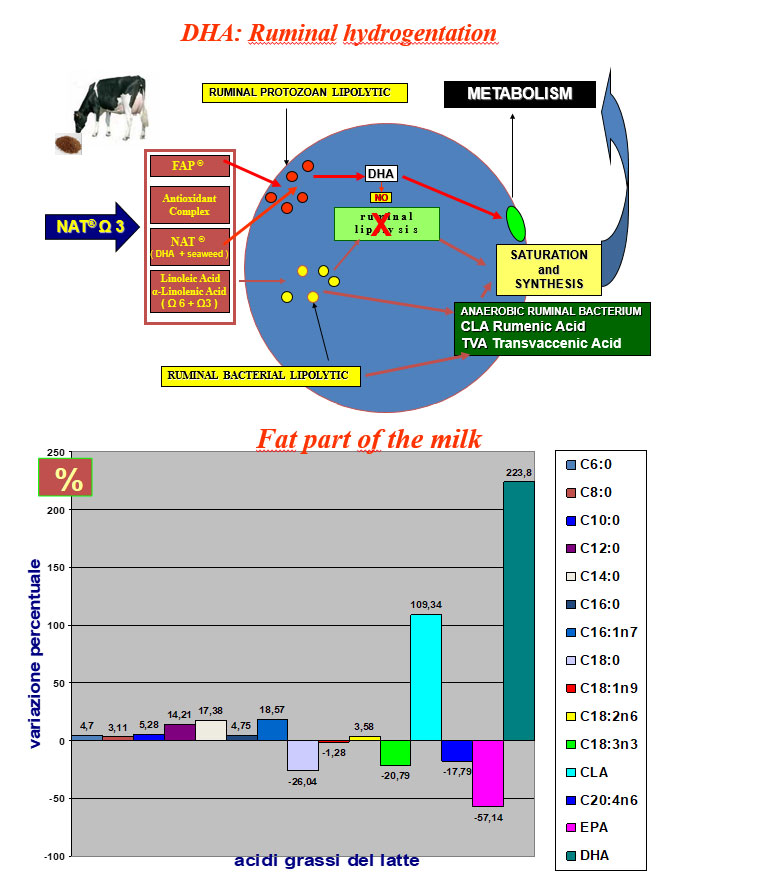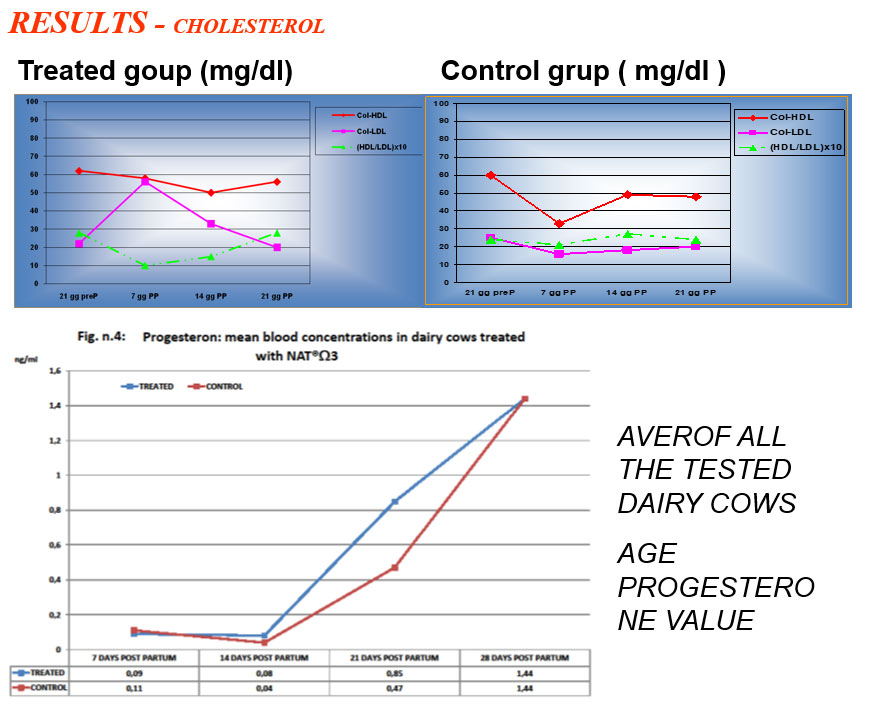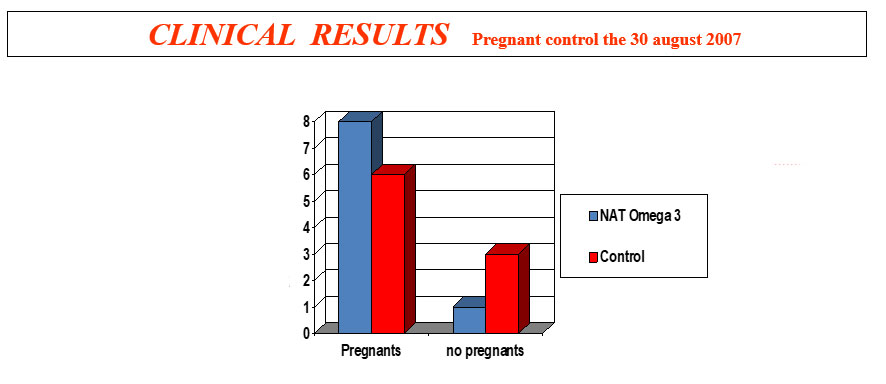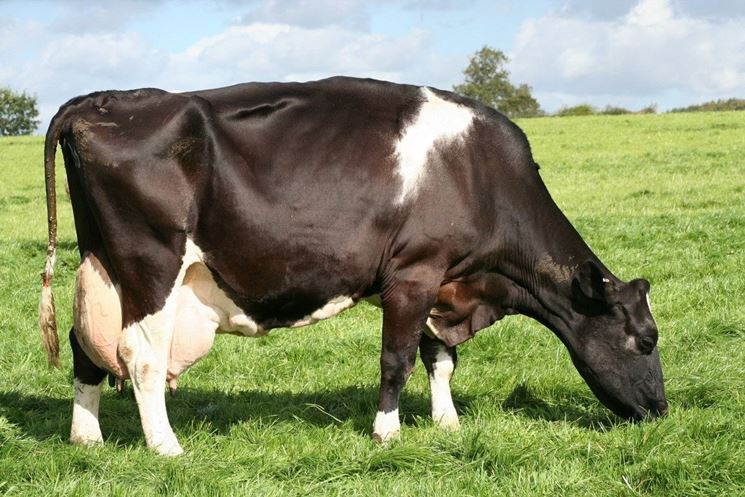GABALDO G. (1), DEPALMA A. (2), FUSARI A. (3), PIZZICARA M. (1), TINELLI S. (2) , UBALDI A. (3)
(1) TE.CO.S. srl – Verona – Italy; (2) Veterinary Pratictioner – Italy ; (3)Dipartimento di Salute Animale, Università degli Studi di Parma – Italia
INTRODUCTION
Polyunsatured Fatty Acid or PUFAs must be introduced compulsorily with the diet. (So called Essential Fatty Acids). Numerosus articles have shown that introducing Omega 6 or Omega 3 in the diet of dairy cows, mainly in risk period as « Transition Period », Improve both reproductive and immune status of dairy cows No trials were performed with an association of those family of PUFAs, neither with a stimulation of Rumen’s flora.
THE DHA IN THE RUMEN
It was found in vitro and in vivo that DHA-enriched micro algae have an inhibitory effect on rumen biohydrogenation of polyunsaturated fatty acids resulting in the accumulation of several hydrogenation intermediates such as conjugated linoleic acid (CLA c9t11), well known for its anticarcinogenic and antiartherogenic effects, and vaccenic acid (C18:1 t11), the precursor of CLA in the mammary gland. Recently Belgian and Dutch researchers (Boeckaert – Vlaeminck and coll – 2007) have demonstrated the accumulation of biohydrogenation intermediates was associated with the disappearance of some rumen ciliates.

IPOTESI DEL RUOLO DEL FAP® nel metabolismo del DHA
LeVif ® : STEMMED FROM A NATURAL TECHNOLOGIC INDUSTRIAL PROCESS, WHICH ENHANCE THE VALUE OF THE GRAIN BY GERMINATION AND LACTIC FERMENTATION
LeVif ® : SYMBIOTIC (probiotic+prebiotic) action on ruminal protozoan population
Compensation for the inhibitory effect of the ruminal protozoan population on D H A
More DHA available in the metabolism

DISCUSSION
- The increase of a part of saturated fatty acids (C12-C14-C16) inthe treated group is balanced by the decrease of C18 (stearic acid)
- At the end the level of saturated fatty acid in the milk is healthier for the human nutrition
- The most interesting part of unsaturated fatty acids for the human nutrition is:
=> CLA: + 109,34% / => EPA + DHA = + 19,48%
With a decrease of EPA (-57%) but a very important increase of DHA (+223,8%)
MATERIALS AND METHODS
A) Study animals
The study took place in five barns of High Productive Dairy Cows (1 in VERONE and 4 in BARI – Italie lt 30/day )
– In VERONE, 20 cows were randomised in 2 groups. The treatment group receive 700g of NAT®Ω3/animal/day during 41 days. It was easy to separate the milk product from each group. However the average day of milk of the treated group was less than 30 days compared to the average day of milk from the control group
-In BARI, the 4 barns were in the same breeding methods. In each farm, 3 control and 3 treated cows were chosen at the same physiological status. The treated group received 700 of NAT®Ω3/animal/day from 21 days before and 21 days after calving. At the end of the study only 18 cows were kept because of different events not linked to the trial.
B) Data Analisis
MILK: CSS, protein, complete fat part. Once a week
BLOOD: Cholesterol level (HDL and LDL), Progesterone. At 21 days before calving and once a week after.
CLINICAL SIGNS: Heat control quality, BCS, Pregnant control

- The LDL value seems to be the most important parameter
- The LDL score increases from 21 days before calving until 7 days after calving and then decrease slowly from 7 days until 21 days after calving
- The HDL/LDL ratio decrease from 21 days before untll 7 days after calving
- The HDL level does not seem to be interesting for the progesterone level and the fertility
- The level of Progesterone in blood increase at 21 days after calving. It seems to be linked to the LDL value which increase a few days before (GUMMER 1988 – SAEZ 1983)
- Progesterone is a profertility factor, therefore use of NAT®Ω3 (21 days before and 21 days after calving) improves the fertility results

1) NAT®Ω3, in transition period, improve:
a) Cholesterol metabolism
b) Level of progesterone and fertility results
c) Quality of the fat part of the milk
2) The study enables a control on dairy cows to identify the ones with a risk of low fertility results and so a prevention using NAT®Ω3

